
Why Make Vegetarian Kimbap
Every time I visit the Asian grocery store I’m tempted by the ready-made vegetarian kimbap. It’s so much fun to eat and I frequently pick up a pack to bring home.
I love the contrasts between the different textures, from the snap of the nori seaweed, the perfect tender rice, creamy egg, and the distinctive crunches of the various veggies.
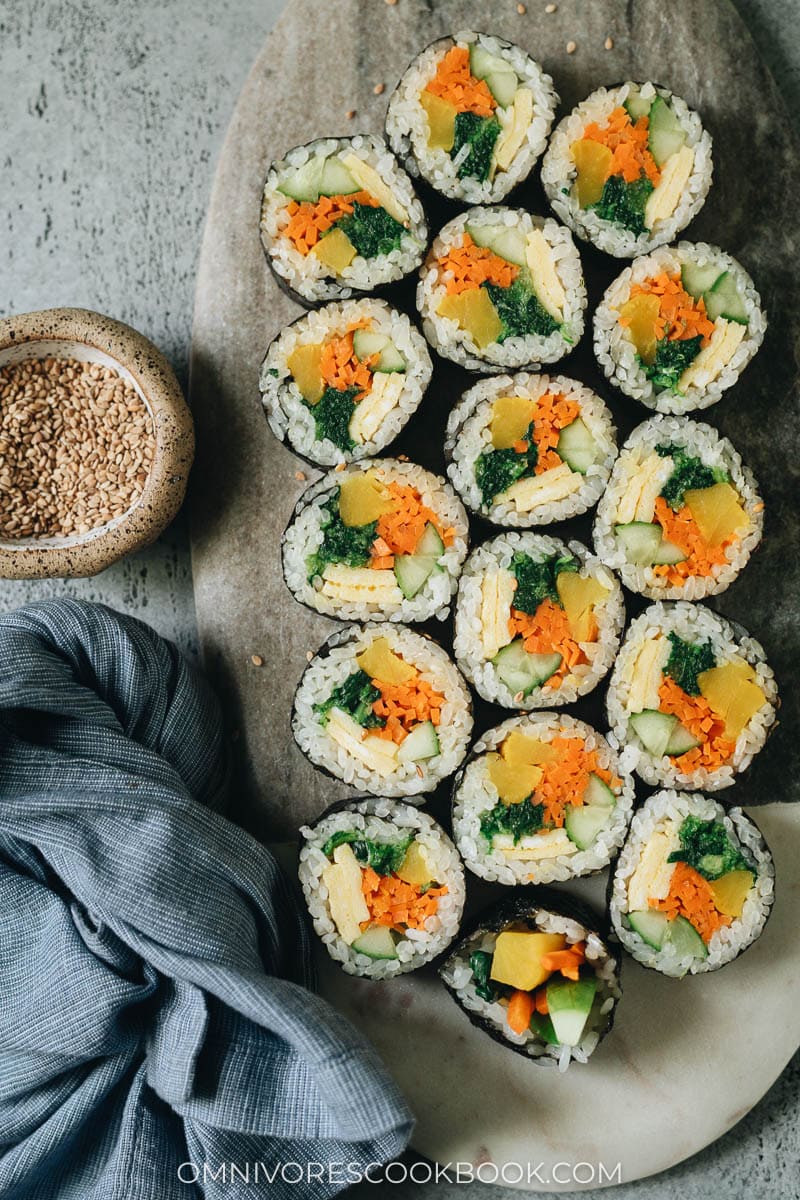
Flavor-wise, the umami of the seaweed is lovely against the mild fragrance of the different veggies. And the Korean pickled radish (danmuji) has a delightful sweet-sour-salty character that shines through everything.
It’s almost like a salad in (“sushi”) roll format: there’s a lot of veggies and a bit of rice and egg. So it’s nicely balanced in terms of nutrition.
So it’s fun to eat, delicious, nutritionally balanced – what’s not to love?
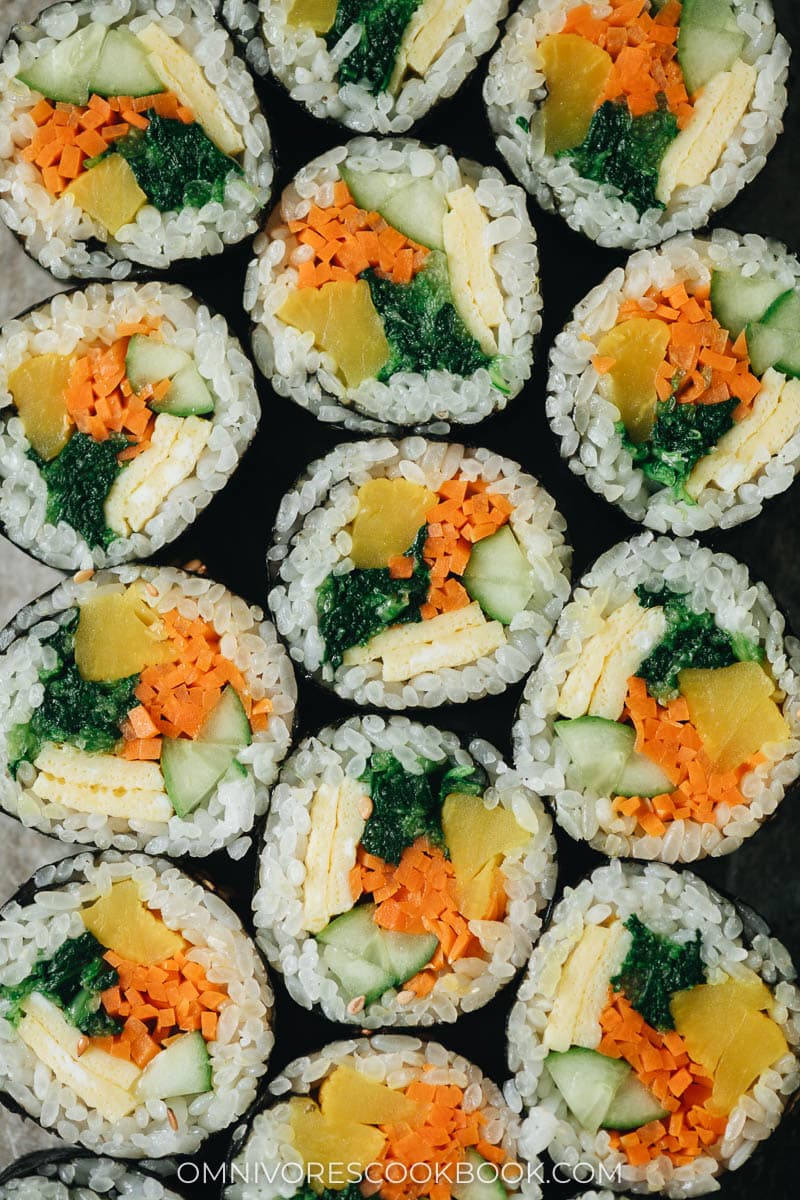
Tips on How to Make Vegetarian Kimbap
Prepare the Ingredients Separately
It might be tempting to try to cook as much of the ingredients at the same time as you can, but resist the urge! You’ll want to cook the spinach and carrot individually, so that you can get them to the perfect level of doneness. If you’re going to cook some of the ingredients in parallel, it helps to have a friend in the kitchen to help.

Blanch and Ice the Spinach
The spinach should be blanched very lightly – no more than 30 seconds – and you want it to have a vibrant green color. Submerging it in the ice bath after cooking will help preserve the perfect degree of color and flavor.
Gently Saute the Carrots
You’ll shred and saute the carrots in oil until they start to turn limp, yet still bright orange and with some of the crunch left. Keep the heat on the lower side so that the carrots do not blister or caramelize.
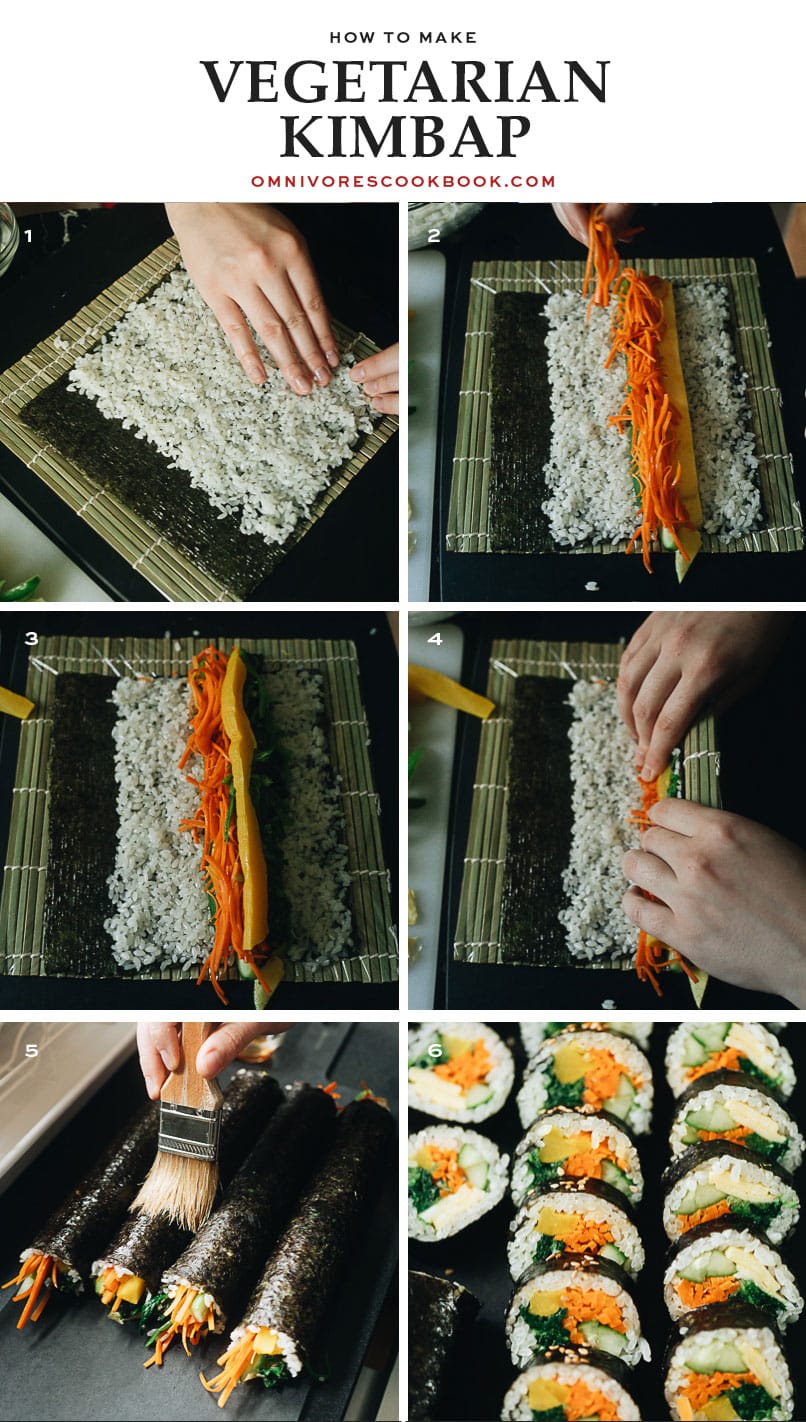
The Ingredients are Flexible
If you’ve got some other veggies on hand or just prefer to use others than I’ve prescribed here, by all means, customize your vegetarian kimbap!
For the best experience, though, you’ll want to use ingredients that have a variety of colors and textures. Some of the satisfaction of the dish comes just from the beautiful appearance of the inside of the roll, with its mini-rainbow palette, and texture will ensure it’s a ton of fun to eat.
See the footnotes in the recipe below for tips on other veggies (and non-veggies) you can add.
Don’t Skip the Danmuji!
There is some flexibility as to what veggies you put in the kimbap. But you really should not skip or replace the Korean pickled radish, aka danmuji.
Danmuji is a bright yellow pickled daikon radish. And you’ll typically find it in the refrigerated section of the Asian grocery store. You can buy it in both cut and whole forms; I like to buy the whole one so I can cut it to the size and shape that I like.
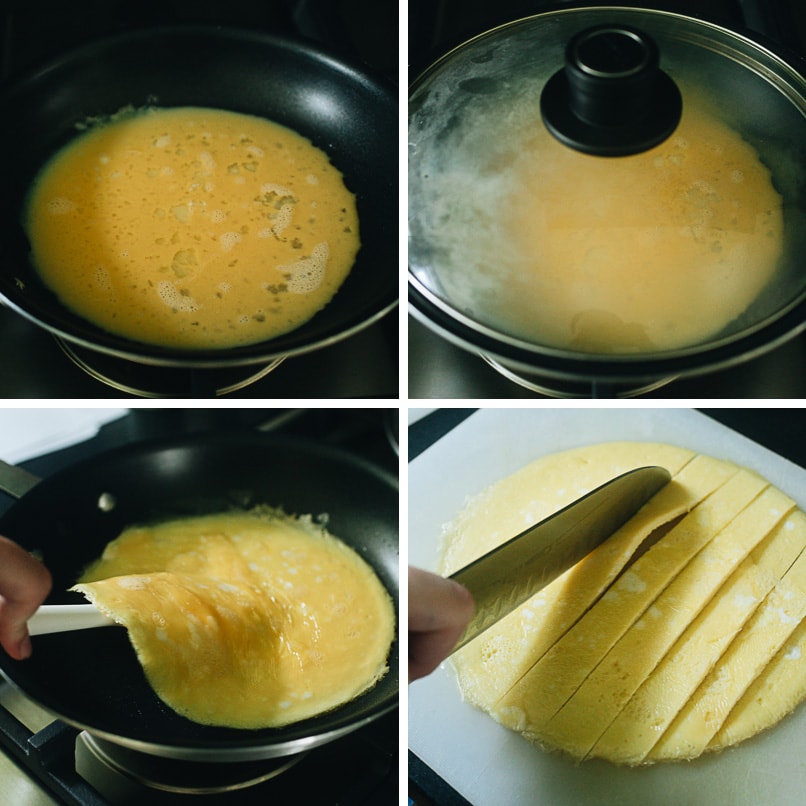
Cook the Egg Until Fully Set
While I do love a runny egg in all sorts of scenarios, I should emphasize that the egg for the vegetarian kimbap should be cooked all the way through.
You don’t want the heat so high that it crisps the edges; the cooked egg should still be quite tender and a nice pale yellow color.
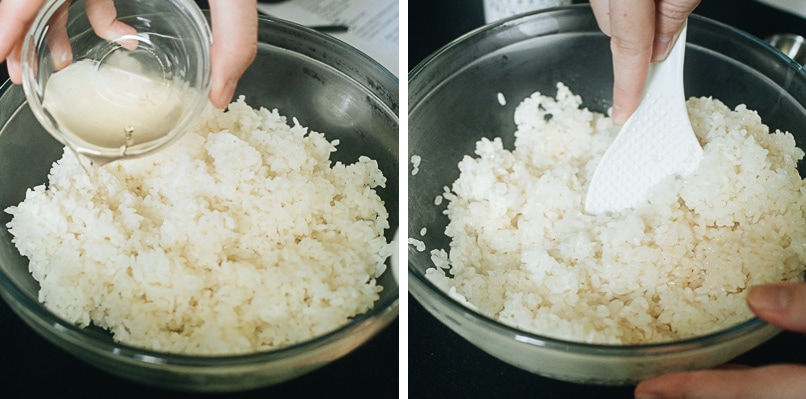
Use Sushi Rice if You Can
Traditional kimbap doesn’t use sushi rice explicitly. But I find that it adds another layer of subtle complexity to the flavor of the kimbap, and the texture is quite nice too. And it somehow elevates the flavors of the seaweed, pickled radish, and other goodies.
By “sushi rice”, I do mean that you should use polished short grain rice from Asia (the package may or may not say “sushi rice” on it. But you should also prepare the rice the way you would for sushi, by adding a mixture of rice vinegar, salt, and sugar.
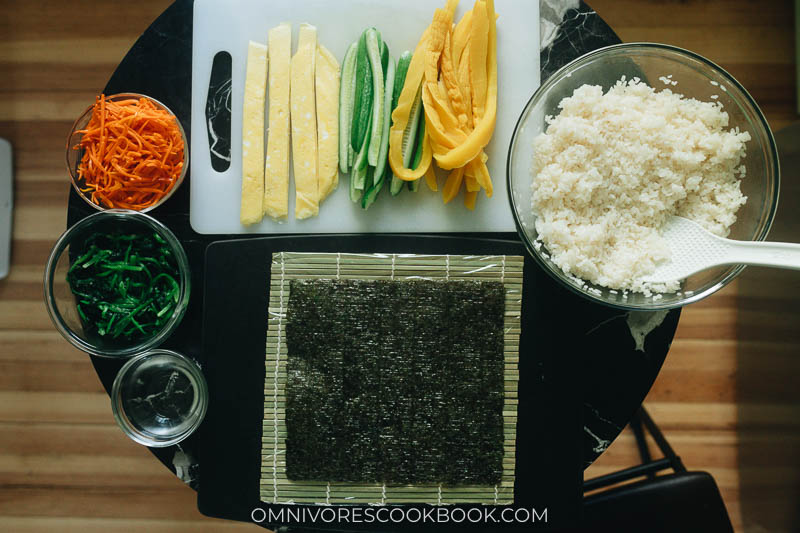
Tips for Serving and Storing Vegetarian Kimbap
Serve Vegetarian Kimbap at Parties
This kimbap is great for parties since you can easily pick up the seaweed-wrapped pieces with your hands and eat them. They’re acceptable both as finger food and eaten with chopsticks.
It doesn’t typically need a dipping sauce, but you have the option of enjoying it with one, such as some combination of soy sauce, vinegar, hot sauce, and/or sesame oil.
Pack it For Picnics
Since it doesn’t need to be refrigerated, vegetarian kimbap is a perfect item to bring on a picnic. Just bag it up or wrap it in plastic wrap and keep it relatively cool and out of the sun until you’re ready to eat it.
I don’t recommend making this a day in advance, though, since the texture of the seaweed is best when you enjoy the kimbap within 8 hours or so of being made.

Eat the Kimbap Within a Day in Any Case
However you plan to serve the vegetarian kimbap, keep in mind that you don’t want to have it around for more than 24 hours if you can help it. It will still be edible, of course, but the nori seaweed will get slightly soggy (it just absorbs moisture from the air) and the perfect texture will diminish.
Putting the kimbap in the fridge will also affect the seaweed, so don’t refrigerate it unless you absolutely have to.
Chinese Cooking Made Easy
Are you new to this website? This free email series is a great place to start. I’ll walk you through a few of my most popular recipes and show you how and why they work. You’ll quickly start to cook better Chinese food in your own kitchen.

Vegetarian Kimbap
Ingredients
Rice
- 1 1/2 cups uncooked short grain rice
- 1 teaspoon salt
- 1 teaspoon sugar
- 2 tablespoons rice vinegar
- 1 tablespoon sesame oil
Spinach (Footnote 1)
- 12 oz (340 g) spinach (about 11 cups)
- 2 cloves garlic , grated
- 1/4 teaspoon salt
- 2 teaspoons sesame oil
Carrot
- 1/2 teaspoon oil
- 1 cup carrot , shredded (yield from 1 medium-large carrot)
- 1/4 teaspoon salt
Eggs
- 2 eggs
- 1/8 teaspoon salt
Other
- 4 pieces toasted seaweed sheets (gim/nori)
- 4 strips danmuji (Korean pickled radish)
- 2 persian cucumbers (or 1/2 english cucumber) , seeds removed and sliced into thin long wedges
Tools
Instructions
Rice:
- Gently rinse the rice by adding running water to cover the rice, swirl the rice in the water with your fingers a few times, and drain off the water. Repeat 1 to 2 times. Cook the rice according to package instructions or by following this guide (or 1:1 rice to water). Once cooked, let the rice sit covered and undisturbed for 10 minutes. Fluff with a paddle and transfer to a large bowl. While the rice is still hot, add the salt, sugar, vinegar, and sesame oil to the rice. Gently cut and fold the seasonings into the rice until the seasonings are fully absorbed. Cover the bowl with a lid or plastic and set aside, it is important the rice be slightly warm when rolling the kimbap for easier rice spreading.
Spinach:
- Bring a pot of water to a boil. Prepare an ice bath in the meantime. Add the spinach to the boiling water and cook for 30 seconds. Remove the spinach, drain, and submerge in the ice bath. Once cooled enough to handle by your hands, squeeze as much water from the spinach as possible, and place it in a bowl. Add the garlic, salt, and sesame oil and toss to mix well. Set aside.
Carrot:
- Heat the oil in a pan over medium heat until hot. Add the shredded carrot and salt. Cook and stir the carrots until they are wilted, 2 to 3 minutes. Transfer to a plate and set aside to cool.
Egg:
- Beat the eggs and salt together in a small bowl. Heat a medium-sized non-stick skillet over medium-low heat and spray (or brush) with a thin layer of oil. Add the egg, do not stir, and cover briefly. Once the egg is mostly set, about 1 to 2 minutes, flip it and cook for another 30 seconds. Remove the egg to a cutting board and slice into 3/4” (2 cm) strips.
Rolling:
- Prepare a small bowl of water. Wear food gloves if available, to help prevent rice sticking to your hands. Cover your rolling mat with a piece of plastic wrap, and use a knife to slit a few lines on the mat. Lay one sheet of seaweed, rough side up and indented lines perpendicular to you, on a rolling mat (or on your work surface if not using a mat). Dip your fingers in the dish of water and pick up about 1 cup of rice, and place in the center of the seaweed sheet. Dip your fingers in the water again and spread the rice evenly across the sheet, leaving 1 1/2” (4 cm) of sheet uncovered at the top. For the best result, aim for the rice to be about two grains tall.
- About 1”(2.5 cm) from the base of the seaweed, start to add the fillings onto the rice. Begin with two strips of egg and one strip of danmuji next to each other. Lay 1 to 2 slices of cucumber on top of the egg, and a layer of spinach on top of the danmuji. On top of everything add the carrots. Lift the base of the seaweed and roll it over the filling, squeezing and pressing from the center out to the edges. Continue rolling until all the rice is rolled, then brush some water along the edge of the seaweed sheet that’s not covered by the rice until it feels sticky and moist. Continue rolling over the wet edge then press down gently to seal. Set aside. Repeat with remaining ingredients.
To serve:
- Brush the top of the rolls with a thin layer of sesame oil and sprinkle with sesame seeds. Slice each roll into 10 pieces and serve at room temperature.
Notes
- Other popular filling options include:
- Crab sticks, sliced lengthwise
- Fish cakes
- Processed ham sausage (like spam or kimbap ham), sliced into long strips
- Skirt steak (seasoned with soy, sugar, garlic, pepper), grilled and sliced
- Tuna salad
- Perilla leaves, thinly sliced
- Marinated and baked tofu, sliced into strips
Nutrition

Did you make this recipe?
I’d love to hear how it turned out for you! Please take a moment to leave a 5-star rating ⭐️ and share your thoughts in the comments further down the page. It really helps others discover the recipe too.
More Korean-Inspired Classics
- Kimchi Fried Rice
- Sundubu Jjigae (Soft Tofu Stew)
- Galbi-Style Marinated Steak
- Seafood Pancake (Haemul Pajeon)
Lilja Walter is a part of the Omnivore’s Cookbook team and worked closely with Maggie to develop and test this recipe.

Happybob122$
Yay
Ubaidullah Rasheed
Today, I have a simple kimbap recipe to share – in Korea, we call it Yachae Kimbap, which translates to Vegetable Kimbap. Despite the name suggesting a veggie focus, it may not be entirely vegetarian, as it includes Korean ham and imitation crab meat. However, for a vegetarian version, you can easily skip these and consider adding seasoned tofu for a tasty twist. It’s a versatile dish with room for customization based on your preferences!
Glitterati
This was really great! I especially appreciated the detailed rolling & storage instructions, and the pictures to help understand the dimensions to cut the ingredients. My toddler tried some and kept pronouncing it “nice!” as he ate like half my portion. Swapped some pan-fried mock pork strips for the egg and that worked well. Definitely going into our rotation, especially for parties! Thanks for the recipe!